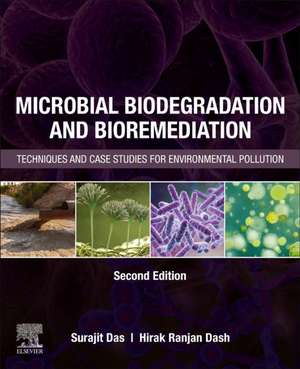Microbial Biodegradation and Bioremediation: Techniques and Case Studies for Environmental Pollution
Editat de Surajit Das, Hirak Ranjan Dashen Limba Engleză Paperback – 26 noi 2021
This completely updated new edition presents many new technologies and techniques and includes theoretical context and case studies in every chapter. Microbial Biodegradation and Bioremediation: Techniques and Case Studies for Environmental Pollution, Second Edition serves as a single-source reference and encompasses all categories of pollutants and their applications in a convenient, comprehensive format for researchers in environmental science and engineering, pollution, environmental microbiology, and biotechnology.
- Describes many novel approaches of microbial bioremediation including genetic engineering, metagenomics, microbial fuel cell technology, biosurfactants and biofilm-based bioremediation
- Introduces relatively new hazardous elements and their bioremediation practices including oil spills, military waste water, greenhouse gases, polythene wastes, and more
- Provides the most advanced techniques in the field of bioremediation, including insilico approach, microbes as pollution indicators, use of bioreactors, techniques of pollution monitoring, and more
- Completely updated and expanded to include topics and techniques such as genetically engineered bacteria, environmental health, nanoremediation, heavy metals, contaminant transport, and in situ and ex situ methods
- Includes theoretical context and case studies within each chapter
Preț: 706.64 lei
Preț vechi: 912.36 lei
-23% Nou
Puncte Express: 1060
Preț estimativ în valută:
135.22€ • 141.53$ • 112.54£
135.22€ • 141.53$ • 112.54£
Carte tipărită la comandă
Livrare economică 24 martie-07 aprilie
Preluare comenzi: 021 569.72.76
Specificații
ISBN-13: 9780323854559
ISBN-10: 0323854559
Pagini: 646
Dimensiuni: 216 x 276 x 40 mm
Greutate: 1.48 kg
Ediția:2
Editura: ELSEVIER SCIENCE
ISBN-10: 0323854559
Pagini: 646
Dimensiuni: 216 x 276 x 40 mm
Greutate: 1.48 kg
Ediția:2
Editura: ELSEVIER SCIENCE
Public țintă
Primary: Researchers in Environmental Science, particularly environmental microbiology and remediationSecondary: Researchers in environmental engineering and microbiology
Cuprins
1. Microbial bioremediation: A potential tool for restoration of the contaminated areas
2. Heavy metals and hydrocarbons: Adverse effects and mechanism of toxicity
3. Nanotoxicity: Aspects and concerns in biological systems
4. Application of molecular techniques for assessment of microbial communities in contaminated sites
5. Microbial indicators for monitoring pollution and bioremediation
6. Biofilm mediated bioremediation of PAHs
7. Nano-particle based bioremediation
8. Bioremediation using extremophiles
9. Role of Actinobacteria in bioremediation
10. Biology, genetic aspects and oxidative stress response of Streptomyces and strategies for bioremediation of toxic metals
11. Fungal bioremediation strategies
12. Microbial bioremediation of industrial effluents
13. Bioremediation of polythene wastes
14. Phycoremediation of contaminated water and soil coupled with generation of value added products
15. Feasibility of using microbial fuel cell technology for bioremediation
16. Microbial bioremediation: A metagenomic approach
17. In-silico approach in bioremediation
18. Microbial bioremediation of greenhouse gases
19. Enzymes/Enzymatic reactions in bioremediation
20. Microbiological metabolism under chemical stress
21. Bioremediation of pesticides: A case study
22. Microalgae in removal of heavy metal and organic pollutants from soil
23. Bioremediation of aquaculture effluents
24. Aquifer microbiology of different geogenic setting for environmental biogeotechnology
25. Exploring prospects of mono-oxygenases based bio-catalyst in xenobiotics and their computational modelling
26. White-rot fungi and their Environmental applications
27. Remediation of environmental pollution by genetically engineered Bacteria
28. Toxicity on human-health and adverse consequences of cosmetics
29. Bioremediation of Steroidal Estrogens
30. Increased coverage of nanoremediation/ Applications and implications of nanotechnology in remediation of environmental pollutants
31. Bioremediation of Heavy Metals/ New insights into bioremediation of toxic metals
32. Expanded coverage of effluents from various industries
33. New Techniques for contaminant transport/ monitoring of contaminant transport
34. In situ and ex situ methods of bioremediation
35. Factors affecting bioremediation
36. Non-molecular methods of monitoring bioremediation
2. Heavy metals and hydrocarbons: Adverse effects and mechanism of toxicity
3. Nanotoxicity: Aspects and concerns in biological systems
4. Application of molecular techniques for assessment of microbial communities in contaminated sites
5. Microbial indicators for monitoring pollution and bioremediation
6. Biofilm mediated bioremediation of PAHs
7. Nano-particle based bioremediation
8. Bioremediation using extremophiles
9. Role of Actinobacteria in bioremediation
10. Biology, genetic aspects and oxidative stress response of Streptomyces and strategies for bioremediation of toxic metals
11. Fungal bioremediation strategies
12. Microbial bioremediation of industrial effluents
13. Bioremediation of polythene wastes
14. Phycoremediation of contaminated water and soil coupled with generation of value added products
15. Feasibility of using microbial fuel cell technology for bioremediation
16. Microbial bioremediation: A metagenomic approach
17. In-silico approach in bioremediation
18. Microbial bioremediation of greenhouse gases
19. Enzymes/Enzymatic reactions in bioremediation
20. Microbiological metabolism under chemical stress
21. Bioremediation of pesticides: A case study
22. Microalgae in removal of heavy metal and organic pollutants from soil
23. Bioremediation of aquaculture effluents
24. Aquifer microbiology of different geogenic setting for environmental biogeotechnology
25. Exploring prospects of mono-oxygenases based bio-catalyst in xenobiotics and their computational modelling
26. White-rot fungi and their Environmental applications
27. Remediation of environmental pollution by genetically engineered Bacteria
28. Toxicity on human-health and adverse consequences of cosmetics
29. Bioremediation of Steroidal Estrogens
30. Increased coverage of nanoremediation/ Applications and implications of nanotechnology in remediation of environmental pollutants
31. Bioremediation of Heavy Metals/ New insights into bioremediation of toxic metals
32. Expanded coverage of effluents from various industries
33. New Techniques for contaminant transport/ monitoring of contaminant transport
34. In situ and ex situ methods of bioremediation
35. Factors affecting bioremediation
36. Non-molecular methods of monitoring bioremediation
